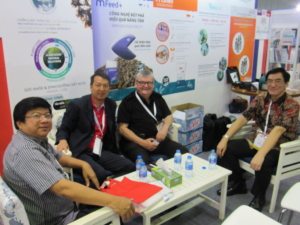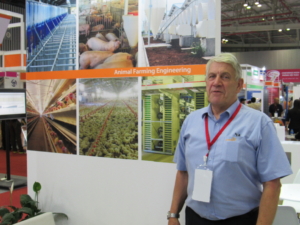 Looking at the calendar it’s possible to spend the year travelling around the world purely attending seminars, shows and trade fairs. Attendees get as much from networking as getting updated on new products – either way new knowledge helps improve business efficiency and profitability.
Looking at the calendar it’s possible to spend the year travelling around the world purely attending seminars, shows and trade fairs. Attendees get as much from networking as getting updated on new products – either way new knowledge helps improve business efficiency and profitability.
Again studying the calendar there are far more trade fairs now in Asia than a few years ago, an indication of the importance of livestock production in this part of the globe. Crucially many trade fairs also have an extensive and wide ranging series of seminar presentations to update attendees on all aspects of swine production.
Vietnam has around 28 million sows ranking the country, 4th in the world and so hardly surprisingly merits several trade fairs – in fact two this year, ILDEX held in March and VietStock, to be held this October.
This year’s ILDEX (International Livestock, Dairy, Meat Processing and Aquaculture Exposition) was the 7th such event held at the SECC (Saigon Exhibition and Convention Centre). The event has grown substantially over the years and this year’s show attracted more than 250 exhibitors from 30 countries, with the Czech Republic, France, Korea and the United States all having national pavilions.
ILDEX attracted 8700 attendees of which 1924 were from abroad. Attendance at trade fairs is generally a reflection on the buoyancy of the industry. Hence when prices are poor attendances are also poor and vice versa. Two years ago producers were getting 50,000 dong / kg live (2.82 CAD) but currently this stands at around 32,000 dong/kg. (1.8 CAD). The Vietnamese pig price had been high due to substantial mainly illegal exports of slaughter pigs across the border to China. These exports were clamped down on and the home market had to absorb these pigs, with over supply putting most producers into a loss situation. Having said that, the show was remarkably busy as attendees were obviously optimistic about the future.
At any show chances are that the biggest stand will be the familiar orange Big Dutchman one, with a variety of equipment on display. Ray Proost is a technical expert with Big  Dutchman, British by birth but now a resident in Vietnam, who is working on a number of different projects. In his opinion the current national herd stands at four million sows. One million are in Western style units, with three million classed as backyard sows. Backyard producers have minimal labour costs and use their pigs as a bank account, selling a pig or two when the family is in need of cash.
Dutchman, British by birth but now a resident in Vietnam, who is working on a number of different projects. In his opinion the current national herd stands at four million sows. One million are in Western style units, with three million classed as backyard sows. Backyard producers have minimal labour costs and use their pigs as a bank account, selling a pig or two when the family is in need of cash.
Despite low costs the number of backyard sows has dropped by 800,000 this year and Proost predicts that the national herd next year will be in the region of three million sows. Significantly it is the older generation that farm the backyard pigs and their children want more free time and do not want to be tied to pigs 24/7. Hence the number of backyard sows will drop permanently. Proost also added that the low farm price has not been mirrored in the price of pork in the shops. But this is something that is not unique to Vietnam.
Nedap is well known for its electronic sow feeding systems and the company is setting up a demonstration farm using Nedap equipment in  conjunction with De Heus. “The commercial market is very difficult due to the current low pig prices,” commented Nedap. Many of the other equipment companies with a presence in Canada were exhibiting. Some well-known Western equipment companies had wet mix installations on show. Whether the Vietnamese industry can handle sophisticated feeding equipment of this type is a moot point as hand feeding is still the norm. However, even in Vietnam labour for pig farms is getting increasingly harder to find. Hardly surprising when feed bags weigh 40kg and are manually carted about in 35C heat. Hence auger systems and conveyors are more in evidence on farm and this trend will increase as time goes by.
conjunction with De Heus. “The commercial market is very difficult due to the current low pig prices,” commented Nedap. Many of the other equipment companies with a presence in Canada were exhibiting. Some well-known Western equipment companies had wet mix installations on show. Whether the Vietnamese industry can handle sophisticated feeding equipment of this type is a moot point as hand feeding is still the norm. However, even in Vietnam labour for pig farms is getting increasingly harder to find. Hardly surprising when feed bags weigh 40kg and are manually carted about in 35C heat. Hence auger systems and conveyors are more in evidence on farm and this trend will increase as time goes by.
With such a huge pig industry many breeding companies are doing business in Vietnam. The US was represented by US Livestock Genetic Exports. Denmark had a presence with Breeders of Denmark A/S. The British Pig Association was also in evidence flying the flag for GB. France historically has links with Vietnam and hence the French pavilion had a high profile.
Cooperl is a French cooperative producing six million pigs per year and has its own genetic subsidiary breeding company Nucleus selling gilts, boars and semen. FRANCEXPORC services was at the show and its export pigs bred by top French breeders. Canadian breeding company Genesus was present at ILDEX, represented by Paul Anderson, S.E. Asia General Manager/ International Sales Manager.
Vietnam is a very important market for the Genesus Yorkshire, Landrace and of course world famous Durocs. In view of the importance attached to the Vietnamese market Genesus has  taken on Hung Van Nguyen as a technical sales manager to promote sales and offer technical support to our customer base. Anderson added “with low end product prices and many producers losing money today is the time to be buying gilts. By the time their progeny are sale weight they will be taking advantage of higher prices. Waiting until high prices return before committing to buying gilts invariably means their progeny will be sold when the market price is in a trough, if history holds true and they will have ‘missed the boat’ price wise.” Mavin Austfeed is a young, rapidly expanding major player in the Vietnamese feed and livestock sector and has just opened its 5th feed mill. “Genesus damline semen has yielded larger litters with heavier pigs, whilst Duroc terminal sire semen has produced faster growing more robust finishing pigs,” commented CEO Dao Manh Luong.
taken on Hung Van Nguyen as a technical sales manager to promote sales and offer technical support to our customer base. Anderson added “with low end product prices and many producers losing money today is the time to be buying gilts. By the time their progeny are sale weight they will be taking advantage of higher prices. Waiting until high prices return before committing to buying gilts invariably means their progeny will be sold when the market price is in a trough, if history holds true and they will have ‘missed the boat’ price wise.” Mavin Austfeed is a young, rapidly expanding major player in the Vietnamese feed and livestock sector and has just opened its 5th feed mill. “Genesus damline semen has yielded larger litters with heavier pigs, whilst Duroc terminal sire semen has produced faster growing more robust finishing pigs,” commented CEO Dao Manh Luong.
Allied to breeding pigs are AI companies and several were at ILDEX. French company IMV had a booth represented by Michel Barre. Spain was represented by Kubus, with German involvement in the Vietnamese market coming from Minitub. “We are expanding in Vietnam through local distributors and are active in 120 different countries,” commented Minitub’s Christoph Spreti.
 The French pavilion had a number of companies under its umbrella. Olmix Group is well known worldwide and now employs over 800 staff worldwide. Mistral is the company’s well known sanitizer and mycotoxin binders are also big sellers for the company. It’s vitally important that the pig industry reduces the amounts of antibiotics used, given the world wide concerns about resistance to antibiotics and the lack of new ones being developed. Olmix has taken a very proactive stance here in terms of using algae extracts as antibacterial agents and have several products on the market. For example the company recently launched Searup in Vietnam. Searup is a complementary feed, administered via the drinking water. Based on marine algae extracts, it reinforces the immune system of the pig. Addressing attendees at the ILDEX Conference Dr. Michel Guillaume, Olmix Technical Specialist commented “since 2016 on our Olmix 840 sow farrow- to -finish trial unit in France, 94.6 per cent of piglets have been reared without antibiotics. Furthermore, DUC S.A., a major French broiler producer is producing antibiotic free chicken ‘thanks to Algae’”.
The French pavilion had a number of companies under its umbrella. Olmix Group is well known worldwide and now employs over 800 staff worldwide. Mistral is the company’s well known sanitizer and mycotoxin binders are also big sellers for the company. It’s vitally important that the pig industry reduces the amounts of antibiotics used, given the world wide concerns about resistance to antibiotics and the lack of new ones being developed. Olmix has taken a very proactive stance here in terms of using algae extracts as antibacterial agents and have several products on the market. For example the company recently launched Searup in Vietnam. Searup is a complementary feed, administered via the drinking water. Based on marine algae extracts, it reinforces the immune system of the pig. Addressing attendees at the ILDEX Conference Dr. Michel Guillaume, Olmix Technical Specialist commented “since 2016 on our Olmix 840 sow farrow- to -finish trial unit in France, 94.6 per cent of piglets have been reared without antibiotics. Furthermore, DUC S.A., a major French broiler producer is producing antibiotic free chicken ‘thanks to Algae’”.
Phileo Lesaffre animal care was promoting Actisaf, probiotics derived from yeast. “Trials in Vietnam showed that when Actisaf was given to gestating sows and also through lactation antibiotic use was reduced by 50 per cent”.
Famsun is a huge Chinese company and was represented by Roger Parfitt, Technical Solutions Chief. “The feed business in Vietnam is dropping. Ingredient prices have gone up by 20  per cent but because of the dire situation facing many producers it has only been possible to raise feed prices to the farmer by two per cent and so margins are being squeezed,” he commented.
per cent but because of the dire situation facing many producers it has only been possible to raise feed prices to the farmer by two per cent and so margins are being squeezed,” he commented.
Given the gloomy state of the Vietnamese industry ILDEX was remarkably buoyant. In two years’ time producers should be back in profit and the 2020 show should attract even bigger numbers. •
— Norman Crabtree





